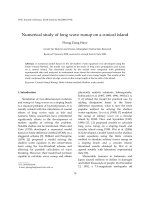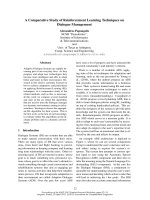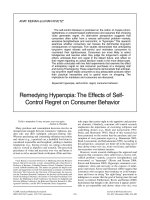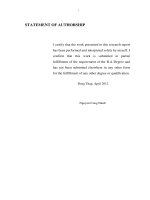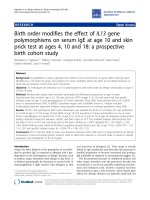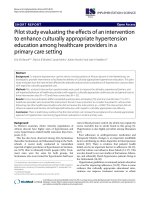study of the effects of self voice recording on speaking speed, word stress accuracy and pronunciation accuracy
Bạn đang xem bản rút gọn của tài liệu. Xem và tải ngay bản đầy đủ của tài liệu tại đây (630.99 KB, 99 trang )
1
STATEMENT OF AUTHORSHIP
This work has not previously been submitted for a degree or diploma in any
university. To the best of my knowledge and belief, the thesis contains no material
previously published or written by another person except where due reference is
made in the thesis itself.
Date: 31/ 07/ 2017
Signature
Nguyen Thi To Hang
2
ABSTRACT
This study was conducted to explore how self-voice recording influences EFL
students’ speaking ability. In the experiment, two groups were following the usual
English program at university while the treatment group did self-voice recording as
a supplementary activity. A general English test, pre-test and post-test were
administered to evaluate the participants’ English proficiency, speaking fluency and
accuracy. The results indicated that the use of self-voice recording can facilitate the
participants’ speaking ability development. The treatment group not only
significantly improved accuracy in pronunciation and word stress but also
remarkably increased speaking speed. Based on the findings, implications for
teaching and learning the speaking skill and suggestions for the future research
were also proposed.
ACKNOWLEDGEMENTS
I have been fortunate to receive invaluable help from many people during my
assignment.
First, I would like to express my deepest gratitude to Dr. Tran Thi Ngoc Yen,
my supervisor, for his immense encouragement, whole hearted and detailed
guidance, without which the assignment could not have been completed.
I would like to thank all the teachers who have taught me during the course
and have given me useful advice and favorable conditions for the completion of
the thesis.
I also would like to show my special thanks to my students who help me a lot
in giving their invaluable comments, efforts and contributions while the work of
this assignment was in progress.
Last but not least, I also owe my indebtedness to my family and colleagues
for their kind co-operation and encouragement which help me in completion of this
study.
Nghe An, July 2017
TABLE OF CONTENT
2.3.3.1
1.4
1.5
Fluency-oriented activities
1.6
Table 2.1: An Analytic rubric example for speaking
1.7
Table 2.2: A Holistic rubric example for a research paper
1.8
Table 2.2: A Holistic rubric example for a research paper
1.9
Table 3.1: Demographic information of participants
1.10
Table 4.1: The treatment and control group’s Score in general English test
1.11
Table 4.2: The average total scores and standard deviations of general English
test
1.12
in the experimental group and the control group
1.13
Table 4.3: Means and standard deviations of eight sessions in the treatment
group Table 4.4: Means and standard deviations of the first and the last session in the
treatment group
1.14
Table 4.5: Increases in the treatment group
1.15
Table 4.6: Summary of the increase levels of all participants
1.16
Table 4.7: Means and standard deviations of participants in eight sessions
1.17
Table 4.8: Number of participants for different change patterns
1.18
Table 4.9: Means and standard deviations of word stress errors in eight sessions
for
1.19
the treatment group
1.20
Table 4.9: Decreases in word stress errors in the treatment group
1.21
Table 4.10: Means and standard deviations of pronunciation errors for the
treatment
1.22
group
1.23
Table 4.11: Decreases in pronunciation errors in the treatment group Table 4.12.:
Means and standard deviation of pre-test results for both groups Table 4.13: Means and
standard deviations of post test results of both groups Table 4.14: Means and standard
deviations of speaking fluency of the pre-test and the post-test of both groups
1.24
Table 4.15: Means and standard deviations of speaking accuracy of the pre-test
and the post-test of both groups
1.25
Table 4.16: Means and standard deviations of pronunciation errors of the pre-test
and the post-test of both groups
1.26
Figure 4.1: The results of general English test of both groups
1.27
Figure 4.2: Progress chart of participant A8/decrease
1.28
Figure 4.3: Progress chart of participant A7/increase
1.29
Figure 4.4 Progress chart of participant B5/ fluctuated increase
1.30
Figure 4.5 Progress chart of participant A3/ gradual increase
1.31
Figure 4.6 Progress chart of participant A15/ mixed increase
1.32
Figure 4.6: Number of participants in word stress error decrease
1.33
Figure 4.7: Number of participants in pronunciation error decrease
1.34
Figure 4.8: A comparison of speaking speed between the control and the
1.35
experimental group
1.36
Figure 4.9: Numbers of participants in speaking speed groups in both groups
Figure 4.10: A comparison of speaking speed between the control and the experimental
group
1.37
Figure 4.11: Numbers of participants in speaking speed groups in both groups
Figure 4.12: The improvement in speaking speed of the control group and the treatment
1.38
Figure 4.13: Decreases in word stress errors of the treatment group and the
control group Figure 4.14: Means of word stress errors in the pre test and post test of
both groups
1.39
Figure 4.15: Decreases in pronunciation errors of both groups
1.40
Figure 4.16: Means of pronunciation errors in the pre test and post test of both
1.41
groups
CHAPTER 1.
INTRODUCTION
1.42
1.1. Introduction
1.43
The speaking skill is viewed as the most substantial part of an EFL
course. The growing need for international communication in the information age
has led many language learners to explore a lot of ways to improve their speaking
ability. This may explain the use of self-voice recording to help students improve
their speaking ability. A lot of studies have shown the positive effects of technology
such mobile phone, podcasts or voice thread but there has not been any research on
whether EFL learners use voice recording as a supplementary activity will help to
improve their speaking ability and what effects it will have on the aspects of
speaking performance such as accuracy and fluency.
1.44
The thesis explores the effects of using self-voice recording on
improving speaking ability for students at Vinh university. A group of second-year
students taking part in this study made two recordings a week. Firstly, the thesis
examined the improvement of speaking accuracy in pronunciation and word stress.
Secondly, the effects of self-voice recording on fluency were also studied. Accuracy
in speaking was measured by the number of errors of pronunciation and word stress
per 100 words, and speaking rate was measured by calculating the number of words
per minute.
1.2 Rationale
1.45 Speaking seems to be the most important skills of all the four
skills (listening, speaking, reading and writing) because people
who know a language are usually referred to as speakers of that
language (Ur, 1996). Knowing a language is not merely knowing
the grammatical rules but also knowing when to say what and to
whom, that is knowledge of how the system is put to use in the
performing of social actions of different kinds. Accuracy and
fluency are the two factors which determine the success of English
language students in the future. However, not all
-7-
1.46
language learners after many years studying English can communicate
fluently and accurately because they lack necessary knowledge. Despite teachers’
efforts to provide students with opportunities to develop their communicative skills,
how to teach and learn speaking skills effectively is still a challenging question to
many teachers and students. It is seen that most Vietnamese learners cannot speak
English fluently because they have paid more attention to learn grammar without
emphasizing the spontaneous language. It is a fact that most students learn
grammatical rules very well but fail to speak fluently and accurately.
1.47
On the other hand, according to Warschauer (1996), the learners
acquire how to use different technological tools within the normal process of
language learning, rather than visiting the computer lab on a once a week basis as
different exercises. Especially the new generation is growing up with technology
and gets familiar with it. According to Wang (2005), there are many advantages
integrating technology in classrooms especially for EFL students. First, using
technology in classrooms also makes the lesson more efficient. Second, there are
many technology tools which can be used in the ESL classes to improve foreign
students’ English skills. Although the benefits of using these tools to improve
students’ foreign language skills, which are reading and writing skills, have been
proven by many researchers, due to the text- based nature of the technological tools,
the students’ listening and speaking skills are not influenced much. Audio
technologies which can provide students with more opportunities to practice
speaking and listening skills are in need.
1.48
Lord (2008) and Brown (2012), who used voice recordings and
selfassessment in an ESL context, both found that there was an improvement in
students’ performances, but the factors that contributed to the change in
pronunciation remains unclear. Dlaska and Krekeler (2008) also addressed this issue
and conducted research in which they compared the self-ratings of advanced
German learners with ratings given by native German speakers. This indicates that
the learners were critical in the self-assessment of their own pronunciation, but
1.49
could not necessarily recognize their own mistakes accurately. Furthermore,
Dlaska
1.50 - 2 -
1.51
and Krekeler’s (2008) findings suggest that explicit instruction on sounds that
do not exist in the learners’ native languages would be beneficial to facilitate the
learners’ awareness of the sounds. According to Shastri (2010), “the teacher need ...
make them aware of correct pronunciation and stress. Our aim of teaching English as
L2 is not to develop British or American accent but to help them overcome regional
accents and wrong pronunciation”.
1.52
Still there has not been much research directly exploring the effects of
voice recording on speaking ability. Therefore, the study entitled “Using voice
recording as a supplementary activity to improve EFL learners’ speaking ability”
was conducted with the hope that the study could make some contributions to the
teaching and learning English speaking for EFL learners.
1.3.
1.53
Aims of the study
This study aimed to examine the effects of self-voice recording on EFL
learners’ speaking ability. Two aspects of speaking performance were taken into:
accuracy and fluency.
1.4.
1.54
Scope of the study
The study only focused on using self-voice recording to improve
English speaking ability for second-year students at Vinh university. However, it
only focused on accuracy in pronunciation and word stress; and speaking rate. Due
to the limitation of time, the study only involved sixty second-year students at Vinh
university, Nghe An province.
1.5.
1.55
Research questions
The thesis was set out to seek the answers to the following questions:
-
How does self-voice recording affect EFL learners’ speaking speed?
-
How does self-voice recording affect EFL learners’ speaking accuracy in
pronunciation and word stress?
- 10 -
1.6.
Thesis format
1.56
The thesis consists of five chapters:
1.57
Chapter 1 is the introduction, which provides a brief introduction,
rationale, aims and scope of the study.
1.58
Chapter 2 is the literature review, in which previous research about the
speaking ability, L1 speaking and L2/FL speaking, assessing speaking ability,
teaching speaking to EFL learners and self-voice recording will be discussed.
1.59
Chapter 3 describes methodology of the study including research
questions, participants, materials and procedures.
1.60
Chapter 4 presents the results of the study of the effects of self-voice
recording on speaking speed, word stress accuracy and pronunciation accuracy.
1.61 Chapter 5 is the conclusion.
1.62
This chapter provides theoretical background relevant to the topic such
as speaking ability, assessing speaking ability, teaching speaking to EFL learners and
using voice recording in teaching and learning foreign languages.
2.1 Speaking ability
2.1.1
1.63
Definition
As Thornbury (2005) defined, speaking is a speech production that
becomes a part of our daily activities. While Underwood (1996) says that speaking
means creative process; an active interaction between speaker and listener that
involves thought and emotion. It means that when someone interacts with other by
using a language as a mean, certainly, they want to convey something important or
express thought aloud using the voice or talk. It is an ability to understand how to
take into account who is speaking to whom, in what circumstances, about what and
for what reason.
1.64
Keith and Marrow (1981) say “Speaking is an activity to produce
utterance to oral communication”. It means that this activity involves two or more
- 11 -
people whom the participants are both hearers and speakers having to react to
whatever they hear and make their contribution a high speed, so each participant has
intention or a set of intention that he wants.
1.65 Burns and Joyce (1997) explain that speaking is an
interactive process of constructing meaning that involves
producing, receiving and processing information. Its form and
meaning are dependent on the context in which it occurs, the
participants, and the purposes of speaking. Speaking is defined
operationally in this study as the secondary stage students'
ability to express themselves orally, coherently, fluently and
appropriately in a given meaningful context to serve both
transactional and interactional purposed using correct
pronunciation, grammar and vocabulary and adopting the
pragmatic and discourse rules of the spoken language.
- 12 -
1.66
Brown (2001) states that speaking is literally defined as to say things,
express thought aloud, and uses the voice. According to him, spoken language and
speaking are similar in meaning that how people use the voice loudly that occurs in
time cannot go back and change, and it is produced and processed on line.
1.67
Heaton (1988) defines that speaking ability as the ability to
communicate ideas appropriate. In order words, speaking ability is the ability to
speak appropriate and effectively in a real communicative situation in order to
communicate ideas to others. English in Indonesia gains high prestige or status.
Rasyid (1988) exemplifies that most job after for private companies require the
applicants to be conversant with English. Civil servants who can speak English are
considered to be distinguished ones.
2.1.2
1.68
The role of speaking in communication
Ur (1996) states that speaking seems to be the most important of all
four skills (reading, writing, listening and speaking). The goal of learning a foreign
or second language is to gain the ability to communicate using the target language.
The students should be made aware that the language they are studying is a tool of
communication. Students do not truly realize that the foreign or second language is
even spoken and exists outside the classroom. In speaking, the students have to learn
how to speak fluently. The communication is effective if the speakers can express
themselves clearly, fluently, and accurately. Therefore, the mastery of speaking skills
in English is a priority for many second-language or foreign- language learners.
Consequently, learners often evaluate their success in language learning on how
much they feel they have improved in their speaking skill. Thus, it emerges many
varieties of approaches to learn speaking, ranging from direct approaches focusing on
specific features of oral interaction to indirect approaches that create conditions for
oral interaction.
2.1.3
L1 speaking vs. L2/FL speaking
1.69
The majority of studies that have examined the transfer of oral
language skills in bilinguals have focused on the relationship between oral language
skills in the L1 and literacy skills in the L2, and generally showed that strong nativelanguage vocabulary skills were associated with better second-language performance
(e.g., Atwill, Blanchard, Gorin & Burstein, 2007; Mumtaz & Humphreys, 2002;
Nagy et al., 1993; Proctor, August, Carlo, & Snow, 2006).
1.70
Nevertheless, some cases about the use of the mother tongue in an FL
class are the result of the transfer of some structural features. According to Noor
(1994), transfer can be positive “if any mother tongue skills facilitate the learning of
skills or parts belonging to the foreign language”, because of the similarities they
could present; however, transfer can be also negative “when it impedes the learning
or has a negative influence over the foreign language’" due to the differences in
skills. For example, Odlin (1989, pp. 27) stated that “transfer resides in the influence
of similarities and differences between the mother tongue and the foreign language
that has been previously acquired". In other words, if the transfer of a skill in the
mother tongue impedes the learning of a skill in the foreign language, there will be
language interference.
1.71
In their research studies, Bhela (1999), Al-Baldawi & Saidat (2011) and
Enisa (2011), stated that learners brought into the form and meaning the mother
tongue through over generalizing the grammatical rules, to cover the structure of
sentences that they did not know in the foreign language; as a result of the
differences in syntactic and morphological structure, the difficulties that the authors
found in foreign language students were verb omission when talking in imperative
utterances, and verb placement in the presence of subject, object and adverb in
declarative utterances; the presence of the object, even if the other constituents are
missing in declarative utterances. Moreover, the authors found some other faults such
as the addition of non-necessary prepositions, and the wrong use of personal
pronouns, verb and number agreements, within the students’ word-for-word
translation as an attempt to communicate themselves in a foreign language.
1.72
In 2010, Ameri & Asareh conducted a study that showed the limitations
of participants in their speech as well as multiple “grammatical non-conformities’"
related to the non-accurate use of verbs, the tendency to use general and simpler
morphological structures and less comparative adjectives, time adverbs and the
proper structure between noun and adjective. The author established the students’
tendency to use their written work to support their speech, the misuse of successive
answers to some questions or the production of successive sentences accompanied by
syntactic disagreements among parts of sentences and semantic errors.
1.73
The knowledge of the mother tongue has positive or negative effects
for the learning of the second language. Teacher can use of first language for
teaching vocabulary of second language in class. There are some words of English
which are not understood by the students’ so teachers use of first language for a
better understanding them. Sometimes the knowledge of mother tongue becomes
prevent in learning English. Therefore, teacher should not use of mother tongue in
teaching writing and speaking of English language. We can say that the use of first
language has negative effects in learning writing and speaking skill of second
language.
2.1.4
1.74
Speaking competence vs. speaking performance
According
to
Nolasco
(1997),
speaking
competence
means
conversation ability or conversation skill. It performs mutual interdependent,
interactive nature of conversation. It is an awareness activity as well as feedback
activity so that a series of tasks are developed to sharpen the students’ awareness on
the activity and assess their own progress performance. When those awareness and
feedback activities are done gradually, automatic conversation becomes accustomed;
speaking ability, in this case, conversation skill, needs gradual practice-controlled,
awareness, and finally fluency conversation.
1.75
Meanwhile, Manitoba (2009) states that language competence is a term
which includes the linguistics or grammatical competence, discourse competence,
sociolinguistics competence and what might be called as textual competence. It refers
to the knowledge of a language, cognitive aspect in learning a language, and of
course the ability to use that language to produce meaningful production and
language performance. The target of having language competence is to be able in
producing the correct utterance, meaningful spoken language, and well-performance
language structure.
1.76
Language performance can be realized by the meaningful of the
students’ classroom activities, assignment and task as the implementation and
application of language competence they have as a result of learning the language
grammatical rule, structure and vocabulary.
1.77
There is a variety of theories that differentiate speaking competence
and speaking performance. Chomsky (1965, as quoted in Finch, 2003) distinguishes
competence and performance as two types of linguistic ability. In linguistics, as cited
by Hamerka (2009, p. 14), the term competence is used to describe the learner's
capacity to produce a language. Another term, performance, denotes the production
of actual utterances as a result of certain psychological processes (de Kort and
Leerdam, as cited in Scha, 1990). Similarly, Fromkin and Rodman (1993) distinguish
competence and performance as follows: “it is a difference between what you know,
which is your linguistic competence and how you use this knowledge in actual
speech production and comprehension, which is your linguistic performance”.
According to Chomsky's theory, our linguistic competence is our unconscious
knowledge of languages and the organizing principles of a language. Then, what we
actually produce as utterances is called linguistic performance (Denham & Lobeck,
2013).
1.78
Language is means of communication, language is a system for the
expression of meaning, and language is viewed as a vehicle for communicating
meaning and messages (Jack C. Richards, and Theodore S. Rodgers (1992)). This
theory underlies that language is not limited in knowing the language itself, but also
it needs the ability to use communicatively and meaningfully. To strengthen this,
Hymes (1971) proposed an idea which bridges the competence and performance that
communicative competence was a definition what the speakers need to know in order
to be communicatively competent in speech community. Thus, a very important thing
in teaching English as a foreign language is that understanding well what the
function of a language actually is and what a language is in order to balance the
students’ competence and performance in that language.
2.2 Assessing speaking ability
2.2.1
1.79
Indicators of speaking ability
Brown (2004) indicates that one can be called have speaking
competence if he/she is able to:
-
Imitate a word or phrase or possibly a sentence (imitative).
-
Produce short stretches of oral language design to demonstrate competence in
a narrow band of grammatical, phrasal, lexical, or phonological relationship
such as prosodic elements-intonation, stress, rhythm, juncture, intensive
ability (intensive).
-
Respond to a very short conversation, standard greetings and small talk,
simple requests and comments, and the like (responsive).
-
Take the two forms of either transactional language which has the purpose of
exchanging specific information, or interpersonal exchanges which have the
purpose of maintaining social relationships (interactive).
-
Maintain social relationships with the transmission of facts and information
(interpersonal).
-
Develop (monologue) oral production including speeches, oral presentations,
and story-telling, during which the opportunity for oral interaction from a
listener is either highly limited or ruled out together (extensive).
1.80
Meanwhile, Ur says (1999) that the characteristics of a successful
speaking activity are as follows:
-
Learners talk a lot. As much as possible of the period of time allotted to the
activity is in fact occupied by learners’ talk. This may seem obvious, but oven
most time is taken up with teacher talk or pauses.
-
Participation is even. Classroom discussion is not determined by a minority of
talkative participants; all get chance to speak, and contributions are fairly
distributed.
-
Motivation is high, learners are eager to speak; because they are interested in
the topic and have something new to say about it or because they want to
contribute to achieving a task objective.
-
Language is of an acceptable level. Learners express themselves in utterances
that are relevant, easily comprehensible to each other, and of an acceptable
level of language accuracy.
2.2.2
1.81
Accuracy, fluency and complexity
Simple definitions of accuracy and fluency have been proposed by
Edge and Garton (2009): accuracy is “conforming to the language system itself, ”
while fluency is “operating the [language] system quickly .” According to H. D.
Brown (2007), “The fluency/accuracy issue often boils down to the extent to which
our techniques should be message oriented (or, as some call it, teaching language
use) as opposed to language oriented (also known as teaching language usage)."
2.2.2.1
1.82
The definition of accuracy
Accuracy is the most easily defined of the triad since there is more
agreement in the goal, which is matching the target language. Housen and Kuiken
(2009) define accuracy simply as “error-free” speech. Accuracy refers to the learner’s
ability to exercise the maximum level of control to prevent errors during a language
performance. In other words, accuracy refers to a learner reducing errors by avoiding
challenging structures that can cause errors (Ellis, 2009). Thus, in order to evaluate
the accuracy of the learner’s language production, researchers have analyzed the L2
production data in terms of how much of the learner’s utterances or compositions
were produced without errors; that is, how many error-free clauses they produced.
Consequently, many studies, including the present study, consider error-free clauses
as a measurement unit that is compared against the total number of clauses and an
important evidence for accuracy evaluation. In addition, Derakhshan (2016) points
out that accuracy in speaking means someone can produce correct sentences in
pronunciation, grammar and word choice so can be understood. There are three
components accuracy: pronunciation, vocabulary, and grammar.
2.2.2.2
1.83
The definition of fluency
Brown (2001) states that fluency is the ability to use a language
spontaneously and confidently and without undue pauses a hesitation. It refers to the
learner’s ability to use the language with a high number of words and without
extensive pauses and corrections during a limited time. Fluency is an aspect that
greatly influences the students ‘ability in speaking English. Simon and Schuster
(1979) defined fluency as the quality of flowing, freedom, expressively, readiness or
smoothness of speech. In a sense of speaking, the speaker should speak comfortably
with native speaker speed and rhythm particularly in every day contexts for more
abstract topic. Byrne (1986) stated that speaking fluency is derived from experience
of oneself. He also added that for the purpose of communication, the language
students must master the language system as much as they can. Studies have used a
variety of methods to measure speaking fluency, such as calculating the following
items: the number of meaningful syllables per total syllables (Yuan & Ellis, 2003),
the number of syllables per minute (De Jong & Perfetti, 2011; Sangarum, 2005), the
word count per C-unit (Robinson, 2003), the word count per T-unit (LarsenFreeman, 2006), and the word count per minute (Oh & Lee, 2012). Other studies
have counted how often hesitations or pauses occur in an utterance or how many
1.84
pauses occur and how long the pauses last in an utterance (Foster & Skehan,
1996; Skehan & Foster, 2005). For measuring the fluency of written language,
scholars will generally count the number of words per composition or per T-unit
(Larsen- Freeman, 2006). According to Paul Nation (1989), “fluency was measured
by calculating the number of words per minute spoken during each of.... deliveries of
the talk, and by calculating the number of hesitations, repetitions, and false starts per
100 words for each delivery.”
2.2.2.3
1.85
The definition of complexity
Complexity has been described as “elaborated language” (Ellis
&Barkhuizen, 2005). The complexity of produced language has been the most
difficult to define and this component of language performance is most easily
conflated with language development or progress. By describing complexity as
“more advanced” or “challenging language”, it seems that complexity is not a
property of language production but just an indication of development or proficiency
(Pallotti, 2009). Complexity can be described relative to proficiency, as “language
that is at the upper limit” of the student’s interlanguage system, which is not fully
internalized or automatized by the learner (Ellis & Barkhuizen, 2005). Skehan and
Foster (1997) connected complexity with “more challenging and difficult language”
or with a “wider repertoire of structures” which is related to “restructuring” of the
learners’ interlanguage.
1.86
According to Norris and Ortega (2009), language complexity can be
1.87
considered a function of sophistication or variety, or a function of syntactic or
1.88
grammatical complexity. It relates to how many clauses the learner connects
or
1.89
includes within a sentence. This construct in L2 production shows the
development
1.90
of the restructuring process within the L2 learners’ inter-language systems
(Skehan,
1.91
1996). The units most frequently used for measuring complexity are the T-unit
(e.g.,
1.92
Larsen-Freeman, 2006; Sangarum, 2005; Yuan & Ellis, 2003;) and the C-unit
(e.g.,
1.93
Foster, 1996; Foster & Skehan, 1996; Rutherford, 2001). In analyzing
complexity,
1.94
the subordinate clause becomes an important criterion. This is because, as a
1.95 - 13 -
1.96
learner’s L2 proficiency increases, the learner uses subordinate clauses more
frequently than coordinating clauses.
2.2.3
1.97
Methods to assess speaking ability
According to Mead, Nancy A., Rubin and Donald L (1985), there are
two methods used for assessing speaking skills. In the observational approach, the
student's behavior is observed and assessed unobtrusively. In the structured approach,
the student is asked to perform one or more specific oral communication tasks. His or
her performance on the task is then evaluated. The task can be administered in a oneon-one setting - with the test administrator and one student - or in a group or class
setting. In either setting, students should feel that they are communicating meaningful
content to a real audience. Tasks should focus on topics that all students can easily talk
about, or, if they do not include such a focus, students should be given an opportunity
to collect information on the topic.
1.98
Both observational and structured approaches use a variety of rating
systems. A holistic rating captures a general impression of the student's performance.
A primary trait score assesses the student's ability to achieve a specific communication
purpose for example, to persuade the listener to adopt a certain point of view. analytic
scales capture the student's performance on various aspects of communication, such as
delivery, organization, content, and language. Rating systems may describe varying
degrees of competence along a scale or may indicate the presence or absence of a
characteristic.
2.2.4
1.99
Rubrics for assessing speaking ability
Andrade (2000) defines a rubric as “a scoring tool that lists the criteria
for a piece of work” and one that “articulates gradations of quality for each criterion,
from excellent to poor”. The rating rubric of speaking consists of two types, namely,
holistic and analytic rubric.
1.100
The analytic rubric is usually preferred when attention
fairly focuses on the response to an interaction (Nitko, 2001).
Analytic rubric results initially in many
- 22 -
1.101 scores, followed by a summary total score representing an assessment
on a multidimensional level (Mertler, 2001). The scoring process of analytic rubrics is
substantially slower performance that the holistic rubric as the consequence of the
assessment process for several different skills. This rubric model requires raters to do
scoring process in several times. Principally, both holistic and analytic rubric
sometimes do not bring comfort performance in conducting speaking assessment. The
general rule of the analytic rubric of scoring is an individual’s work must be assessed
in a separate time for each performance of the task (Mertler, 2001). However, the
beneficial use of the analytic rubric is substantial enough to influence the test takers in
order to be more aware of their test (Liao & Hsu, 2014). As stated that the use of the
analytic rubric may reflect the scoring process to be much slower. It requires the rater
to review the performance production several times.
1.4
Table 2.1: An Analytic rubric example for speaking
1.5 Criteria 1.6
Ne
1.7
S
ver
ometime
1.10 Makes eye contact 1.11 0
1.12 3
1.15 Volume is
1.16 0
1.17 2
appropriate
1.20 Enthusiasm is
1.21 0
1.22 2
evident
1.25 Summary is
1.27 4
1.26 0
accurate
1.30
Total
1.32
1.8
Alwa 1.9
ys ore
1.13
4
1.18
4
1.23
4
1.28
8
Sc
1.14
1.19
1.24
1.29
1.31
(Source:Dr. Jesus R. Dela Rosa. (2011). Developing rubrics. Instructor, English
Language Center.)
1.33
1.102
1.103 The holistic rubric leads the rater to evaluate or score the overall
components of communicative competences without considering another component
of language production separately. This rubric requires the rater to evaluate or score
the components of language production separately (Moskal, 2000; Nitko, 2001).
Holistic rubric is formally used when high errors possibly transpire in some parts of
the production process (Chase, 1999). Nitko (2001) further declares that the use of a
holistic rubric is probably more appropriate when the task requires participants to
- 23 -
create various responses. Principally, the holistic rating rubric reports the overall
quality, proficiency or understanding of the content and skills (Mertler, 2001). This
typical rubric only provides limited feedback to the students’ language development in
their profile of score. It potentially brings a curiosity to the students’ scores report and
it frequently reflects a discourage appearance to the students to attend the next test.
1.34 Table 2.2: A Holistic rubric example for a research paper
1.35 Criteria
1.36 Score
1.37
Mastery = usually makes eye contact; volume is always
1.38
appropriate; enthusiasm present throughout presentation; summary
is completely accurate.
1.39
Proficiency = usually make eye contact; volume is always
1.40
appropriate; enthusiasm is present in most of presentation; only one
or two errors in summary.
1.41
Developing = sometimes makes eyes contact; volume is
1.42
sometimes appropriate; occasional enthusiasm in presentation; some
errors in summary.
1.43
Inadequate = never or rarely makes eyes contact; volume is
1.44
inappropriate; rarely shows enthusiasm in presentation; many errors
in summary.
1.45
(Source: Dr. Jesus R. Dela Rosa. (2011). Developing rubrics. Instructor,
English Language Center^
1.46
1.104
1.105 A typical rubric is called Practical Rating Rubric of Speaking Test
(P2RST) (Ammang Latifa, 2015). The special thing of P2RST rubric was
collaboration of analytic and holistic rubric of scoring mechanism where the rater does
not waste their time to score the test result of the participant. This rubric equips four
scales of band score for every component of communicative performance. The typical
communicative performance employed in P2RST rubric is namely vocabulary
competence, grammar competence, pronunciation competence, discourse competence,
- 24 -
strategic competence. The P2RST rubric practicality is available in the
1.106 three views of perception, namely simple accumulation of scoring mechanism;
the P2RST rubric does not operate extra time; the P2RST does not operate high cost.
Table 2.3: A P2RST rubric example for a speaking task
- 25 -
